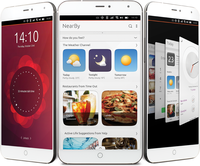Maximized
Meizu has now brought the fastest Ubuntu cellphone to market with the MX4 Ubuntu Edition. The phone offers an octacore CPU and a 20.7 megapixel camera; however, the MX4 also has some weaknesses.

Meizu
Meizu has now brought the fastest Ubuntu cellphone to market with the MX4 Ubuntu Edition. The phone offers an octacore CPU and a 20.7 megapixel camera; however, the MX4 also has some weaknesses.
Google and Apple dominate the smartphone market with Android and iOS. According to a May 2015 report [1] by the global market intelligence firm IDC, just under 80 percent of all smartphones sold are Android. Apple has 16 percent market share but, even so, the company takes in 90 percent of the profits, thanks to enormous margins. Microsoft is limping very far behind with just over 3 percent of the market share. The remaining manufacturers, including the one-time market leader Blackberry, share a very slim one percent.
Mozilla, Nokia, and Tizen rank among the also rans. Mozilla has its own Firefox OS [2], ex-Nokia people have developed Sailfish OS [3], and Tizen [4] is supported by the Linux Foundation. Thanks to a series of cooperative efforts and low-priced devices, Mozilla has already enjoyed some success. Currently, it has more than 10 percent market share in emerging economies like Brazil and Venezuela [5]. Canonical is in fourth place in open source offerings with Ubuntu Touch and Ubuntu Phone [6].
Unlike competing products, Ubuntu Touch comes without any additional buttons on the cellphone. Instead of buttons, a series of gestures must be committed to memory and they are a little different from what users might be familiar with from Android or iOS. Depending on which side of the screen is used to initiate the gesture, you will open the user menu, messages, and fast settings, or you will switch from one active app to another. The phone reacts differently to gestures initiated from the left or the right depending on whether you swipe quickly or whether you drag across the center of the display screen.
[...]